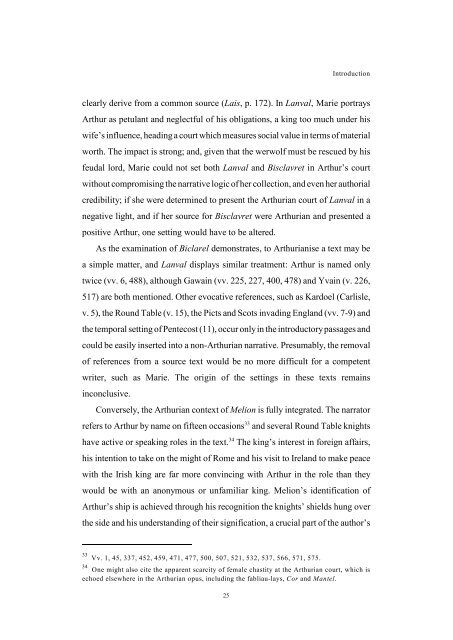Melion and Biclarel - University of Liverpool
Melion and Biclarel - University of Liverpool
Melion and Biclarel - University of Liverpool
Create successful ePaper yourself
Turn your PDF publications into a flip-book with our unique Google optimized e-Paper software.
Introduction<br />
clearly derive from a common source (Lais, p. 172). In Lanval, Marie portrays<br />
Arthur as petulant <strong>and</strong> neglectful <strong>of</strong> his obligations, a king too much under his<br />
wife’s influence, heading a court which measures social value in terms <strong>of</strong> material<br />
worth. The impact is strong; <strong>and</strong>, given that the werwolf must be rescued by his<br />
feudal lord, Marie could not set both Lanval <strong>and</strong> Bisclavret in Arthur’s court<br />
without compromising the narrative logic <strong>of</strong> her collection, <strong>and</strong> even her authorial<br />
credibility; if she were determined to present the Arthurian court <strong>of</strong> Lanval in a<br />
negative light, <strong>and</strong> if her source for Bisclavret were Arthurian <strong>and</strong> presented a<br />
positive Arthur, one setting would have to be altered.<br />
As the examination <strong>of</strong> <strong>Biclarel</strong> demonstrates, to Arthurianise a text may be<br />
a simple matter, <strong>and</strong> Lanval displays similar treatment: Arthur is named only<br />
twice (vv. 6, 488), although Gawain (vv. 225, 227, 400, 478) <strong>and</strong> Yvain (v. 226,<br />
517) are both mentioned. Other evocative references, such as Kardoel (Carlisle,<br />
v. 5), the Round Table (v. 15), the Picts <strong>and</strong> Scots invading Engl<strong>and</strong> (vv. 7-9) <strong>and</strong><br />
the temporal setting <strong>of</strong> Pentecost (11), occur only in the introductory passages <strong>and</strong><br />
could be easily inserted into a non-Arthurian narrative. Presumably, the removal<br />
<strong>of</strong> references from a source text would be no more difficult for a competent<br />
writer, such as Marie. The origin <strong>of</strong> the settings in these texts remains<br />
inconclusive.<br />
Conversely, the Arthurian context <strong>of</strong> <strong>Melion</strong> is fully integrated. The narrator<br />
33<br />
refers to Arthur by name on fifteen occasions <strong>and</strong> several Round Table knights<br />
34<br />
have active or speaking roles in the text. The king’s interest in foreign affairs,<br />
his intention to take on the might <strong>of</strong> Rome <strong>and</strong> his visit to Irel<strong>and</strong> to make peace<br />
with the Irish king are far more convincing with Arthur in the role than they<br />
would be with an anonymous or unfamiliar king. <strong>Melion</strong>’s identification <strong>of</strong><br />
Arthur’s ship is achieved through his recognition the knights’ shields hung over<br />
the side <strong>and</strong> his underst<strong>and</strong>ing <strong>of</strong> their signification, a crucial part <strong>of</strong> the author’s<br />
33<br />
Vv. 1, 45, 337, 452, 459, 471, 477, 500, 507, 521, 532, 537, 566, 571, 575.<br />
34<br />
One might also cite the apparent scarcity <strong>of</strong> female chastity at the Arthurian court, which is<br />
echoed elsewhere in the Arthurian opus, including the fabliau-lays, Cor <strong>and</strong> Mantel.<br />
25
















